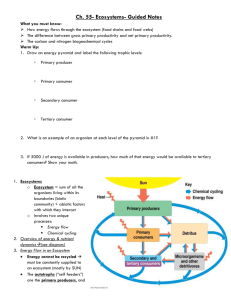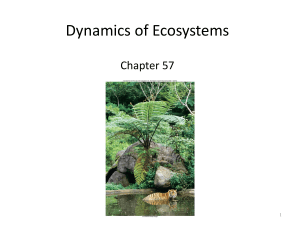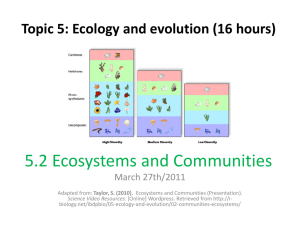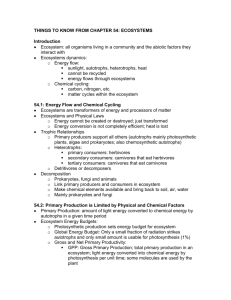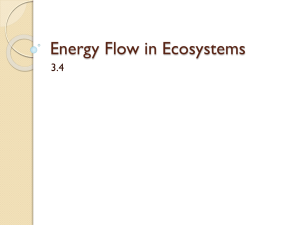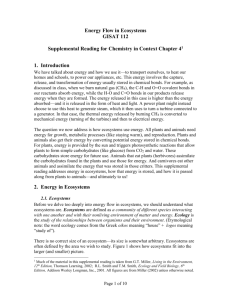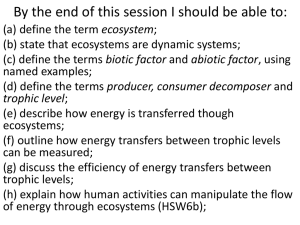PPT
advertisement
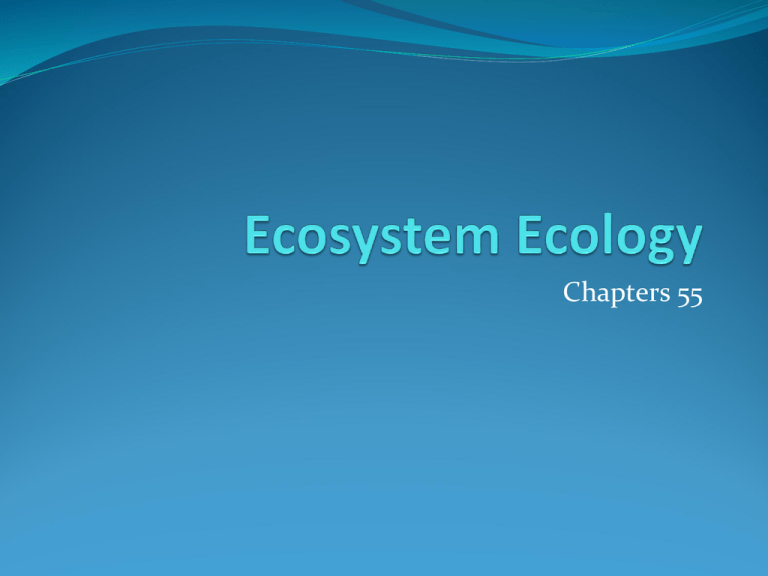
Chapters 55 Concept 5: Ecosystems – Analyzing productivity, energy flow, and chemical cycling. Ecosystems (Ch 55) How energy flows though the ecosystem by understanding the terms that relate to food chains and food webs The difference between gross primary productivity and net primary productivity The carbon and nitrogen biogeochemical cycles Ecosystems consist of all the organisms living in a community, as well as the abiotic factors with which they interact Ecosystems range from a microcosm (aquarium) to a large area such as a (forest, lake) Ecosystem Dynamics involve two main processes: energy flow and chemical cycling Flow of Energy The first law of thermodynamics states that energy cannot be created or destroyed, only transformed Energy enters an ecosystem as solar radiation, is conserved, and is lost from organisms as heat The second law of thermodynamics states that every exchange of energy increases the entropy of the universe In an ecosystem, energy conversions are not completely efficient, and some energy is always lost as heat Cycling of Chemicals • The law of conservation of mass states that matter cannot be created or destroyed • Chemical elements are continually recycled within ecosystems • Ex) In a forest ecosystem, most nutrients enter as dust or solutes in rain and are carried away in water Overall: Ecosystems are open systems, absorbing energy and mass and releasing heat and waste products Trophic Levels Autotrophs - build molecules themselves using photosynthesis or chemosynthesis as an energy source Ex) plants and algae Ex) chemosynthetic bacteria on hydrothermal vents Heterotrophs - depend on the biosynthetic output of other organisms Trophic Levels Energy and nutrients pass from: Primary producers (autotrophs) to Primary consumers (herbivores) to Secondary consumers (carnivores) to Tertiary consumers (carnivores that feed on other carnivores) Detritivores, or decomposers, are consumers that derive their energy from detritus, nonliving organic matter Prokaryotes and fungi are important detritivores Decomposition connects all trophic levels Try This! Which of the following is absolutely essential to the functioning of an ecosystem? A) producers B) producers and herbivores C) producers, herbivores, and carnivores D) detritivores E) producers and detritivores Primary Productivity (Lab 12!) The amount of light energy converted to chemical energy (organic compounds) by an ecosystem’s autotrophs during a given period of time Background: Photosynthesis (required light energy) carbon dioxide + water → glucose + oxygen Cellular Respiration (generates ATP – energy currency) glucose + oxygen → carbon dioxide + water Primary Productivity • Gross primary production (GPP) – Total primary production of the ecosystem • Net primary production (NPP) – GPP minus energy used by primary producers for respiration • Only NPP is available to consumers • Ecosystems vary greatly in NPP and contribution to the total NPP on Earth Ecological Efficiency Describes the proportion of energy represented at one trophic level that is transferred to the next trophic level On average, efficiency is only ~10% 10 percent of the productivity of one trophic level is transferred to the next level. The remaining 90% is consumed by individual metabolic activity or to detritovores Applications: Farming: Energy required to raise and sustain carnivores is far greater than that of herbivores… we eat cows, we ride horses Bioaccumulation as you go up the trophic levels Ex)High mercury in tuna and swordfish Ex) High toxicity levels in orcas Ecological Pyramids Used to show relationship between trophic levels Horizontal bars or tiers: represent relative size in terms of either: Energy (productivity) Biomass Numbers of organisms Tiers are stacked in the order in which energy is transferred. Try This Which of the following is not true of a pyramid of production? A) Only about 10% of the energy in one trophic level is passed into the next level. B) Because of the loss of energy at each trophic level, most food chains are limited to three to five links. C) The pyramid of production of some aquatic ecosystems is inverted because of the large zooplankton primary consumer level. D) Eating grain-fed beef is an inefficient means of obtaining the energy trapped by photosynthesis E) A pyramid of numbers is usually the same shape as a pyramid of production Biogeochemical Cycles Describes the flow of essential elements from the environment to living things and back to the environment. p. 1209-1214 in Campbell For each of the following essential elements, you much know: The reservoirs (major storage location) The process of assimilation (incorporation into plants and animals) The process of release (how it returns to the environment) Biogeochemical Cycles Hydrolytic Cycle (water cycle) Carbon Cycle (required for the building of all organic compounds) Nitrogen Cycle (required for the manufacture the building blocks of proteins and nucleic acids) Phosphorus Cycle (required for the manufacture of ATP and all nucleic acids. Cycle is similar to other mineral cycles like calcium) Try This The finding of harmful levels of DDT in grebes (fish- eating birds) following years of trying to eliminate bothersome gnat populations in a lakeshore town is an example of... Try This The finding of harmful levels of DDT in grebes (fish- eating birds) following years of trying to eliminate bothersome gnat populations in a lakeshore town is an example of... BIOLOGICAL MAGNIFICATION Concept 5: Ecosystems – Analyzing productivity, energy flow, and chemical cycling. Ecosystems (Ch 55) How energy flows though the ecosystem by understanding the terms that relate to food chains and food webs The difference between gross primary productivity and net primary productivity The carbon and nitrogen biogeochemical cycles


